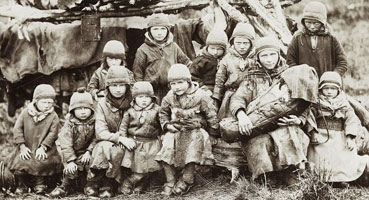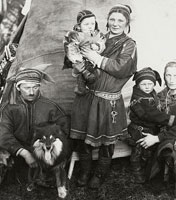Revitalising the Sami languages

Nomad Sami in late 1890s
Earlier this month, on the sixth of February, we celebrated the Sami national day. I really think the Sami culture deserves celebration, because the mere fact that it still exists is something of an achievement. I am under the impression that people in Britain tend to think about Scandinavia as some sort of happy Utopia where everything is perfect: Lots of money which is equally distributed among a population without class divisions or conflicts, tolerance and abundance all around, although there is a slight tendency to commit murder in dark, wintery, remote forest locations. However, Scandinavia does have its dark sides too, and I am not talking about “Nordic Noir” here, but about the repression of the Sami culture.
The Sami people nowadays live across a large area known as Sápmi, spanning over parts of Norway, Sweden, Finland and Russia. As far back in time as anyone knows, the Sami people have lived in these countries alongside Norwegians, Swedes, Finns and Russians. In Norway, the Sami population is mainly concentrated in the counties of Finnmark and northern Troms (as well as, of course, in Oslo, due to modern urbanisation). There are nine living Sami languages, which are related to one another, but different enough to be counted as separate languages by the Ethnologue index of world languages. These are known as North Sami, South Sami, Lule Sami, Pite Sami, Inari Sami, Ter Sami, Skolt Sami, Kildin Sami and Ume Sami.

Sami family in Finland 1936
Next year, in 2014, when Scotland holds its referendum on independence, Norway will be celebrating its two hundredth anniversary of breaking away from Denmark and getting its own constitution and parliament (although a union of crowns with Sweden remained until 1905). In the new Norwegian nation in the first decades after 1814, the Sami population and languages were treated with courtesy and basic respect, with clergymen operating along the premise that it was a human right to speak one’s native tongue. Parts of the Bible was translated into North Sami by Nils Stockfleth, a Norwegian theologian who spent years in the 1820s-40s gaining fluency in the language and compiling a North Sami dictionary and grammar.
However, in the mid-19th Century, attitudes changed for the worse. Following pressure from the Norwegian upper class of Finnmark, the Norwegian parliament decided it wanted to assimilate the Sami people, so in 1851 it set aside a separate budget post known as “Finnefondet” (the Sami fund) for the purpose. “Finnefondet” had to its disposition quite a large sum of money for the time, and in today’s money it would be comparable to what the modern Sami parliament disposes. Henry Minde, in his article “Assimilation of the Sami. Implementation and consequences” in the journal Gáldu cála, Journal of Indigenous Peoples Rights, number 3/2005, gives us an insight into the relentless assimilation efforts which followed the establishment of “Finnefondet”. The goal was to make everyone speak, read and write Norwegian, and to bring education, “enlightenment” and the Christian faith to these traditionally nomadic people, many of whom were reindeer herders.
The assimilation policy was implemented “with school as the battlefield and teachers as frontline soldiers,” according to Minde. An instruction to teachers was passed, which said: “Teachers should do their utmost to spread knowledge of the Norwegian language and promote the use of this (…). All Sami children should be taught to read, speak and in writing use the Norwegian language. Norwegian is the language of tuition.” As sadly happens with many speakers of minority languages, Sami children were sent to schools where they met teachers who deliberately refused to communicate in a language the children understood. Instead, the children were forced to learn the majority language, and in many cases humiliated when they struggled to understand.
In the second half of the nineteenth century, Norway went through a nation building process, which intensified with the dissolution of the union of crowns between Norway and Sweden in 1905. The “Finnefondet” budget, which was already high, was further increased, and money was spent on building boarding schools in Finnmark, aiming to further isolate Sami children from their home communities in the hope that it would make the assimilation process faster. This technique was also applied to the First Nations communities in Canada, among whom many Orcadians have distant relatives.
The official Norwegian policy towards the Sami came to be reflected in the Norwegian-speaking population’s attitude. Minde writes: “It was not the ‘real’ history of the Sami which was of significance, but rather contemporary perception and experience of the Sami’s past. And within this horizon of understanding, all things Sami were regarded as beggarly, old-fashioned, reactionary and – in many circles – heathen.”
We can observe such a prejudiced attitude in the following quote by Christian Brygfjeld, who was Director of Schools Finnmark from 1923-35: “The Lapps [Sami] have had neither the ability nor the will to use their language as written language. (...) The few individuals who are left of the original Lappish tribe are now so degenerated that there is little hope of any change for the better for them. They are hopeless and belong to Finnmark’s most backward and wretched population, and provide the biggest contingent from these areas to our lunatic asylums and schools for the mentally retarded.” And this is the person who is in charge of the brutal assimilation programme in the schools! One has to wonder whether the schoolchildren had much chance at all, when struggling against such massive prejudice. To this man, assimilating the Sami was a case of “civilisation”.
Against this background, it is maybe no wonder that the proportion of people in the municipality of Kvænangen in northern Troms which reported themselves as being Sami sank from 44 % to zero between 1930 and 1950. Right enough, the local community had been evacuated during World War 2, but many returned and the population in 1950 consisted of many of the same individuals as in 1930. They had just started concealing their Sami identity.
The prohibition against speaking Sami at school was alive even into the 1960s. But in the last 30-40 years, conditions have improved for the Sami people. The Alta conflict of 1979-81 regarding a hydroelectric development in the Alta river engaged large numbers of people, both ethnically Sami and Norwegian. The Sami population pointed out that building a dam would destroy areas used by them and the reindeer, as well as Sami cultural heritage sites and natural diversity. It came to demonstrations, arrests and hunger strikes. A good thing about it was that the media attention put Sami interests on the agenda, and the Alta conflict is therefore regarded as a watershed. Although the Sami actionists lost in court, the development was downscaled from the initial plans, and the Sami people won better rights to be heard in the long run.
It might also have helped that as the 1980s and 90s progressed, the icy grip of the “Cold War” was starting to thaw. Already from the 19th century on, the Sami had suffered under their association with another minority group: The Kvens, who immigrated into Sami areas from Finland. Politically, Norway was afraid of Finland as a potential instrument of Russian foreign policy. This perceived danger was referred to as the “Finnish Menace” (ref. Eriksen and Niemi, Den finske fare). The Sami way of life which involves movement over large areas, and the fact that the Sápmi territory crosses Cold War borders, also didn’t help in this political climate. In addition to the end of the Cold War, there has been a general turn towards more positive attitudes to indigenous minorities internationally, with Unesco working to safeguard minority rights.
Today, according to data from the Ethnologue survey, Northern Sami is the most vital Sami language with 20 700 speakers in 1995 (Norway, Sweden, Finland). Southern Sami has around 600 speakers (Sweden and Norway), Lule Sami had 1500 speakers in 1995 (Sweden and Norway), Kildin Sami had 500 speakers in 2007 (Russia), Skolt Sami had 420 speakers in 2001 (Finland), Inari Sami had 300 speakers in 2001 but few child speakers (Finland), Ume and Pite Sami had a mere 20 speakers each thirteen years ago, and may now be on the very cusp of extinction, Ter Sami had just 10 speakers in 2004 (Russia), whereas Akkara Sami (Russia) is extinct.
One has to admire how these communities survived a century of cultural and linguistic repression. There are now encouraging developments happening. A Sami Parliament was opened in Norway in 1989, and the North Sami language is doing reasonably well with official support such as media broadcasts, schools, and official use in bilingual municipalities and in the Sami College. There has also been a positive development lately for the still endangered South Sami language, for example through the South Sami Nursery established in 2002 in Snåsa municipality, and Saemien Sijte: the South Sami Museum and Culture Centre. There are vibrant art, craft, and musical traditions in the Sami communities, which combine heritage (such as duodji craft and yoik song) and renewal. Musicians such as Mari Boine and Frode Fjellheim are popular and well worth listening to, as well as Nils-Aslak Valkeapää who already in the 1960s when yoik was in danger of dying out revitalised it by combining yoik and jazz. Sami writers such as Synnøve Person and Hege Siri combine literature and visual arts in new ways (see Harald Gaski: Song, Poetry and Images in Writing: Sami Literature), although they, of course, have to face the dilemma that the small size of the Sami language communities means that publishers can’t profit from Sami literature and have to rely on state support. There is also good collaboration across the national borders within Sápmi, for example through joint efforts of the Sami parliaments in Norway, Sweden and Finland.
Ragnhild Ljosland